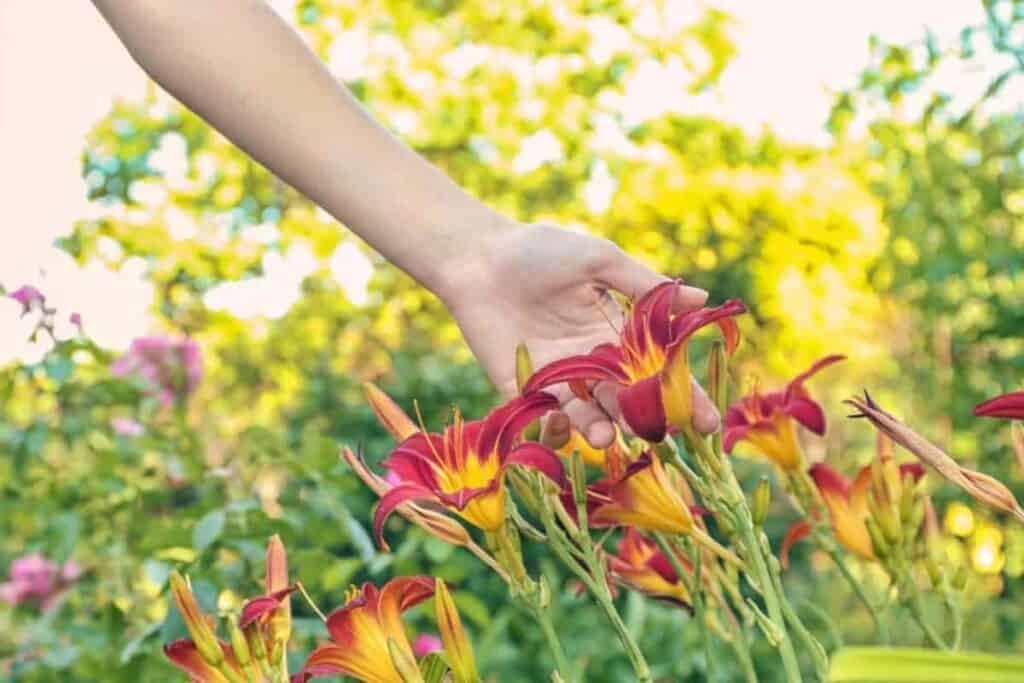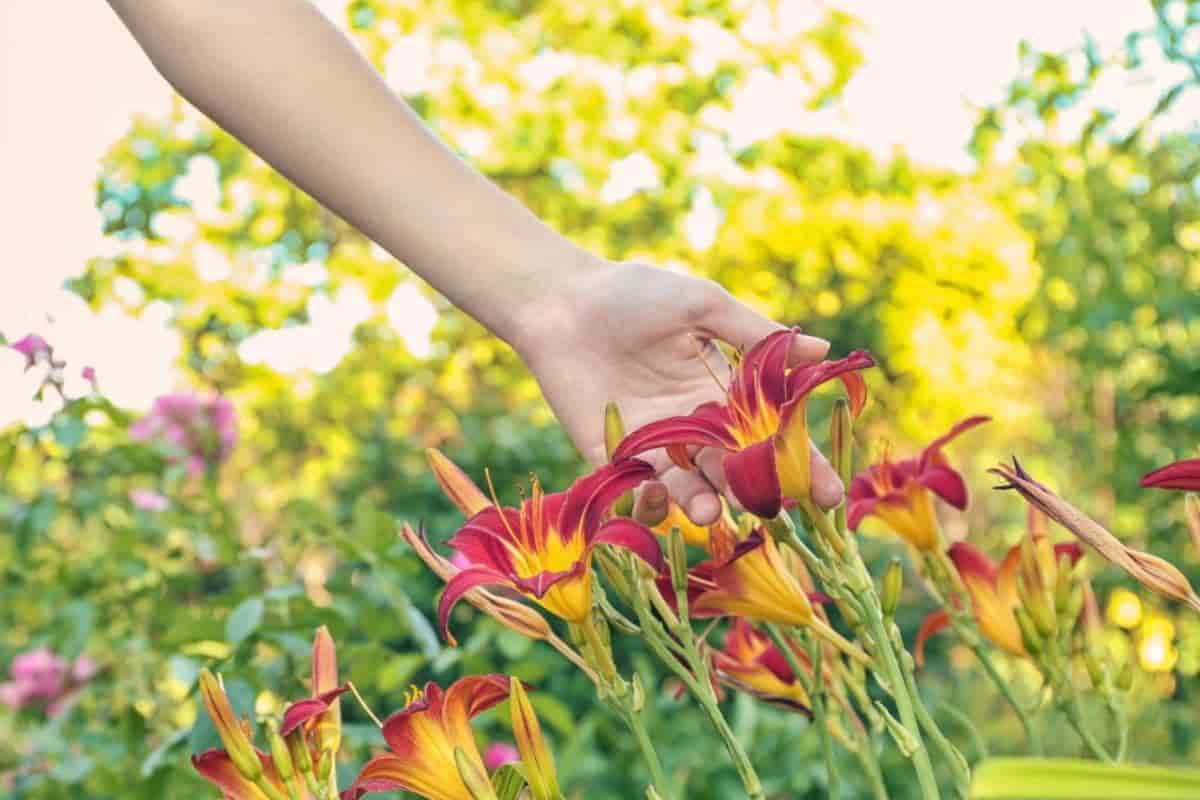It is easy to explain today’s great popularity of the hemerocallis or daylily, to use its better-known name, and to understand why interest in it is growing by leaps and bounds nationwide.
In the first place, it comes as close to being foolproof as any plant in the garden; it flourishes in almost any sort of climate and soil; it is virtually immune to insect pests and disease. And it has a long blooming season.

When in addition to all these virtues, are added a wide range of colors and heights and attractive variations of form, is it any wonder that these exquisite lily-like flowers are headed toward the top of the popularity poll of Summer perennials?
A National Society Grows
Attesting to the nationwide interest in “hems,” the Hemerocallis Society, despite its relatively-recent origin, now boasts a membership of over fifteen hundred.
Many will be coming to New England for the annual national meeting in Boston this year from July 23-July 26, with headquarters at the Hotel Somerset.
Various garden visits and other entertainment have been planned for these enthusiasts gathering from all parts of the country.
Despite the unusual achievements of the hybridizers over the past two decades, many garden lovers (and many horticulturists and writers about gardens, too) still think of hemerocallis in terms of the common, tawny daylily (Hemerocallis fulva) or the roadside and the small, lemon yellow day-lily (F flava) that blooms in May and June.
These two species have plenty of admirable qualities. Still, they simply cannot stand comparison with the creations of present-day plant breeders any more than the iris of twenty-five years ago can stand comparison with most of the new varieties.
Remarkable Range Of Colors
So far, there have been no blue or white daylilies, but it would be dangerous to predict that there soon won’t be.
A truly remarkable range of color has already been developed: from pinks and roses, through lavenders and purples, to glowing reds and maroons; yellows, from cream and palest lemon to rich golden tans and oranges.
Beautiful contrasting bi-colors and delicious blends of mingled hues are also available. There is, moreover, a wide variation in height: one can choose from dwarfs of twenty inches or so lip to five-foot giants.
The variations are fascinating as to the form and size of the actual flowers; some blooms are much recurred with long and narrow petals and sepals, while others produce a broad and solid effect. Still, others are star-shaped or in flaring trumpet form.
The diameter of the blooms runs from about two inches to over seven inches in some of the newer, large-flowered varieties. Then, for further variation, ‘there is the matter of time of bloom.
Although July and August, generally speaking, are the great daylily months in the Northeast section of the country, by careful selection of early, medium, and late blooming varieties, one can have a surprisingly long and rewarding succession of bloom extending from the middle of June into the early autumn.
American Hybridizers Perform
Tracing the development of the modern hybrid daylily, mention must be made of such well-known English Bariculturists as George Yield and Amos Perry, but the greatest progress over the past 25 years has taken place in the United States.
Among the names of American hybridizers, there first comes to mind that of Dr. Anew B. Stout, creator of a galaxy of fine hemerocallis.
Other pioneers were Carl Bctscher, Franklin B. Mead, Bertrand Farr, Hans Sass, and Mrs. Thomas Nesmith.
Of these pioneers in the field, Mrs. Nesmith is still very active. Her distinguished work in the field of the iris (for which she recently received the Hybridizing Medal of the American Iris Society) has been paralleled by her great success with daylilies.
Indeed, over 50 of the hundred favorite varieties in the first Popularity Poll of the Hemerocallis Society conducted in 1949 originated either by her or by Dr. Stout.
From Mrs. Nesmith’s Fairmount Gardens in Lowell, Mass., there continues to come to a steady succession of widely acclaimed and much sought-after introductions.
New Varieties Developed
In contrast with the candid hybridizers of 25 years ago, today, hundreds of men and women are intent on improving every aspect of the daylily.
New varieties are developing in all sections of the country, and gifted hybridizers like Russell, Wheeler, Bechtold, Milliken, Lester, Douglas, Krause, Taylor, McDade, Cook, Hall, House, Henry Sass, Saxton, and Merry, to name just a few of the more prominent specialists, are now making hemerocallis history and many more are joining the ranks each year.
Not even the iris can boast of a more devoted or rapidly growing following.
Yet, in the opinion of veteran observers, the hybrid daylily is still in its infancy, and the wonders that have been achieved are merely forerunners of greater wonders to come.
Practical Aspects of Planting And Care
Daylily culture is delightfully easy. No painful warnings about what to do and what not to do are necessary.
The daylily is the ideal perennial for the lazy gardener. Incidentally, on that account, it is particularly adapted for use around the Summer cottage, where most of us want a maximum bloom with a minimum of effort.
While the plants will respond to fertilization, watering, and careful cultivation, they will withstand an astonishing amount of neglect.
Pink Prelude
So wide excellent varieties are now available at a low cost that there is little excuse for not having a first-rate display of daylilies.
Some of the newest things, like Mrs. Nesmith’s magnificent Pink Prelude, are scarce and costly. Still, many of the most popular varieties may be purchased for modest sums, especially about the abundance of growth established plants will quickly produce.
Long Bloom Period
What to select is largely a matter of taste. Except for some of the evergreen types, which are not completely hardy in Northern climates, the hemerocallis, as previously mentioned, is very tolerant of growing conditions. Consequently, there is little risk of picking out something that won’t do well.
Certainly, it is difficult to be dogmatic about the specific varieties of hemerocallis the average gardener should grow given the wide choice of color, form, and height, to say nothing of differences in the blooming season.
The best solution is to visit a hemerocallis specialist where the would-be purchaser can note what appeals color-wise and judge qualities such as vigor of growth, branching, and the substance of the individual blooms.
The specialist will be able to advise on all these matters and also on the blooming season of particular varieties so that a long period of bloom can be obtained by proper selection.
In choosing varieties, it is best to check carefully on height and follow the accepted rules of using the taller varieties at the back of the border and the lower-growing varieties toward the front.
However, very handsome effects may be obtained by planting daylilies along paths or treating them as small flowering shrubs at focal points in the garden or near the house.
Bewildering Array of Varieties
Gardeners who have not kept up with daylily progress will be perhaps confused by the bewildering array of varieties to be seen in a commercial garden.
But again, once primary matters of height and blooming season have been determined, it is largely a matter of taste and pocketbook.
Every lover of hemerocallis has his favorites, and he likes to make up recommended lists in the various color categories for the enlightenment of the uninformed.
The prospective purchaser, armed with these lists, comes upon varieties that he likes better than those on the lists and that, in actuality, are equally meritorious. He hesitates, nonetheless, to fly in the face of supposed authority and ends in “confusion worse confounded.”
Twenty Favorite Varieties
It is hard to go wrong, however, with the tested choices or thousands of hemerocallis lovers.
It so happens that the first 20 daylily favorites, as determined by the 1951 Popularity Poll of the hemerocallis Society, comprise a broad range of colors, heights, and blooming seasons (and most of them are not expensive).
All in all, they represent an extremely well-balanced collection that should prove a happy and rewarding introduction to the delights of the modern daylily.
1. Painted Lady (Russell); large, ruffled yellow with an overlay of cinnamon.
2. Potentate (Nesmith); rich, pansy purple.
3. Garnet Robe (Milliken); deep, ox-blood red.
4. Hesperus (Sass); cadmium yellow.
5. Caballero (Stout); bicolor of red and gold.
6. Pink Charm (Nesmith); deep, coral pink.
7. Colonial Dame (Milliken); light apricot and tan, subtle in its coloring.
8. Georgia (Stout); blend of buff, pink, and peach, a rich combination.
9. Mission Bells (Hall); medium yellow.
10. Dauntless (Stout); pale yellow.
11. Royal Ruby (Nesmith); glowing red.
12. Mrs. Hugh Johnson (Russell); dark red.
13. High Noon (Milliken); deep yellow.
14. Revolute (Sass); lemon yellow.
15. Prima Donna (Naylor); buff.
16. Orange Beauty (Sass); light orange.
17. Patricia (Stout); pale yellow, green throat.
18. Valiant (Cook); medium orange.
19. Gay Troubadour (Nesmith); brilliant red and yellow bicolor.
20. Dominion (Stout); rich, reddish brown.
44659 by Na
